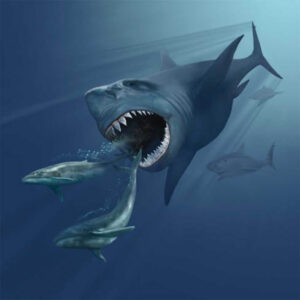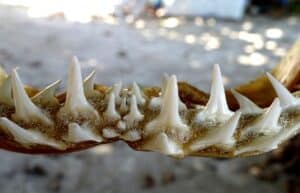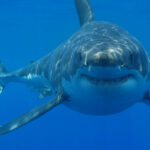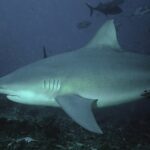Two humongous sharks, entirely different in temperament and lifestyle, are basking sharks and megalodon. And while one does not exist anymore, the other is the living second-largest fish in the world.
Megalodons are the largest sharks of all time, but basking sharks are the second-largest modern-day shark (also fish). However, both sharks are fascinating predators, and although one was a vicious carnivorous, the other one is a filter feeder. Still, there are certain fundamental ways in which both sharks are different.
Key Takeaways:
| Aspect | Basking Sharks | Megalodon |
|---|---|---|
| Basic Information | – Second-largest modern-day shark | – Largest shark of all time |
| – Filter feeder | – Carnivorous predator | |
| – Cetorhinus maximus | – Otodus megalodon | |
| – Cetorhinidae | – Otodontidae | |
| – Up to 30 feet in length | – Up to 67 feet in length | |
| – 10,000 lbs (weight) | – 50-75 tons (weight) | |
| – Swim speed: 2.5-4 mph | – Swim speed: 11 mph | |
| – Diet: Plankton, small fish, | – Diet: Whales, sea turtles, etc. | |
| invertebrates | – Senses: Smell, low-light vision, | |
| Ampullae of Lorenzini, Hearing | ||
| – Bite force: They do not bite | – Bite force: 40,000 psi | |
| or chew | ||
| – Not likely dangerous to humans | – Thought to be aggressive towards | |
| humans if still alive | ||
| – Lifespan: Up to 50 years | – Possibly up to 150 years |
| Factors to Consider | Basking Sharks | Megalodon |
|---|---|---|
| Size | – Up to 30 feet | – Up to 67 feet |
| – 10,000 lbs (weight) | – 50-75 tons (weight) | |
| – Smaller compared to megalodon | – Considered the largest fish | |
| Diet | – Filter feeders | – Carnivorous predator |
| – Plankton, small fish, | – Whales, sea turtles, other fish, | |
| invertebrates | and marine creatures | |
| – Do not actively hunt | – Actively hunted and killed prey | |
| using stealth | ||
| Hunting Style | – Passive filter feeding | – Active predator, stealth hunting |
| – Swim with mouths open | – Trailing and ambushing prey | |
| Teeth and Bite Force | – Teeth not used for tearing | – 7-inch long teeth with a bite |
| prey | force of 40,000 psi | |
| – Teeth mainly for chewing | – Teeth used for capturing and | |
| small prey | killing prey | |
| Behavior | – Docile and passive | – Aggressive carnivore |
| – Non-aggressive | – Attacked and hunted actively | |
| – Gentle and non-threatening | – Dominated as an apex predator | |
| Swim Speed | – 2.5-4 mph | – 11 mph |
| – Slower compared to megalodon | – Faster, agile swimmer | |
| Defense Systems | – Minimal active defense | – Acute senses, massive jaw, |
| mechanisms | biting force, camouflaging | |
| – Rely on size and non-aggressive | – Active defense mechanisms, | |
| behavior | including powerful jaws and senses |
There is no doubt that both megalodon and basking sharks have intrigued generations of marine experts, researchers, and filmmakers. And keeping those in mind, we have created this post where we will be answering some of the most frequently asked basking shark vs. megalodons.
This post is purely informative and does not claim any scientific expertise.
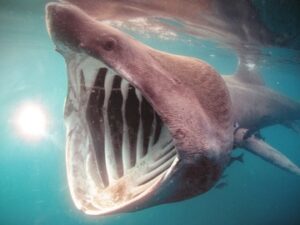
Basking Sharks vs. Megalodon: Basic Information
Megalodon was a giant shark that lived million years ago and ruled the ocean. On the other hand, basking sharks are also huge but much docile and passive. Hence before, delving deep into the comparative study here is a summarized version of basic facts about these shark species.
| Comparing Parameters | Basking Sharks | Megalodon |
| Scientific name | Cetorhinus maximus | Otodus megalodon |
| Family | Cetorhinidae | Otodontidae |
| Genus | Cetorhinus | Otodus |
| Distribution | Worldwide in temperate latitudes | Almost all major marine environments. Most fossils have been found in Europe, Africa, the Americas, and Australia. |
| Weight | 10,000 lbs | 50-75 tons |
| Length | Up to 30 feet | Up to 67 feet |
| Swim speed | 2.5- 4 mph | 11 mph |
| Diet | Filter feeders | Whales, sea turtles, etc. |
| Senses | Smell | Smell Good (low-light) vision Ampullae of Lorenzini Hearing |
| Bite force | They do not bite or chew | 40000 psi |
| Danger to humans | Not likely | Thought to be aggressive towards humans if were alive. |
| Lifespan | Up to 50 years | Maybe up to 150 years |
Are Megalodons a Myth or a Reality?
It is through the fossilized teeth of megalodons that experts have learned about them. But we never saw these sharks in reality, which raises the question is they ever existed in reality?
Megalodon was real. The fossilized teeth that have been found in different parts of the world are really of megalodon sharks. And it is their 7 inch long teeth that estimated that these sharks were humongous and fell into the 60-70 foot range. That said, the megalodon was the largest known fish to ever existed on earth.
When compared with modern-day basking sharks, it was found that the megalodon is larger and weightier than these sharks. These sharks, however, went extinct as a result of possible climate change. Still, it is fascinating to learn that megalodons co-existed with dinosaurs!
Are Basking Sharks and Megalodon the Same?
We all know that the megalodon and basking sharks belong to the shark species. But are they really the same to any extent?
The meg and basking sharks are not similar. One of the main things to consider is that while med was purely carnivorous, basking sharks prefer to feed on planktons and smaller fish and invertebrates. In fact, to a great extent, basking sharks do not comply with the general features of modern-day sharks.
There are some vast differences between these two shark species, which we will discuss in the following sections.
Factors to Consider While Comparing Basking Sharks and Megalodons
To compare the med with basking sharks and analyze who will win over whom, we need to create a hypothetical fight scene between these two sharks. Also, we should take into consideration the key factors that create differences between them.
The following could be some of the factors we can study to shed light on how basking sharks are different from megalodon.
- Size
- Diet
- Hunting style
- Teeth and bite force
- Behavior
- Swim speed
- Defense system
All these factors will make subsequent sections in our post, which we will discuss in detail.
Chances of a Basking Shark Indulging in a Fight With a Megalodon
Since we are imagining a potential fight scene between a basking shark and a megalodon, it is worth noting if these sharks will indulge in a fight in the first place.
The possibility of a basking shark getting into a fight with a megalodon is almost nil. The reason is simple- basking sharks are not apex predators. They are docile and prefer to stay without bothering their surroundings. However, if megalodons were lurking in the marine world, they might have attacked basking sharks as potential prey.
If the second scenario had occurred, there might have been a fight between the two of them. However, we must keep in mind that the basking shark would have been fighting for its life.
Basking Shark vs. Megalodon: Who is Bigger

Scarlet23 (CC BY-SA 3.0) from Wikimedia
When comparing a basking shark with a meg, exploring their size and weight is something that cannot be overlooked. Let’s inspect in detail.
Both basking sharks and megalodons fall under the category of huge sharks. But the latter is without any doubt the bigger and larger. That said, a basking shark can reach 30 feet in length and weigh roughly 10,000 pounds, whereas a megalodon could reach 67 feet in length and weighed between 50 and 75 tonnes.
It’s worth noting that the meg was bigger than even a T-Rex. As a result, these sharks still hold the position of the world’s largest sharks. The meg’s bigger stature gave it the advantage over its prey. These sharks were daunting and deterring for other smaller sharks as well.
In this regard, the meg has the upper hand.
Basking Shark vs. Megalodon: Diet
The diet of sharks is big. Bigger sharks usually feed on smaller sharks, small fishes, and other invertebrates. However, we cannot take the diet uniformly for all sharks.
The diet of both basking sharks and the meg is huge. However, they do not feed on similar food. Basking sharks primarily are filter feeders, which means they filter ocean water to take in planktons, small fishes, and invertebrates. These sharks do not attack any larger fish. On the contrary is the meg, whose diet involved other shark species, sea turtles, whales, and so on.
It’s worth noting that the megalodon has been known to attack and eat humpback and whales. As a result, it is not unreasonable to assume that if megalodon existed today, it would not hesitate to hunt down and consume basking sharks.
So, the thumbs-up goes for the meg in terms of food habits or diet.
Basking Shark vs. Megalodon: Hunting Style
Sharks are known to be keen hunters. They use their senses to find and hunt down their prey. However, there are differences between the hunting style of basking sharks and megalodon.
Megalodons were stealth hunters. Before leaping upwards and biting, these sharks trailed and hid behind their prey without letting them know. Basking sharks, on the other hand, do not actively hunt. Instead, they swim with their mouths open, allowing the ocean water to filter in the floating planktons through their filter pads.
Every shark’s hunting style is determined by its diet or feeding habits. Because basking sharks don’t devour larger prey, they don’t need to actively hunt. Megalodons, on the other side, needed to devour bigger fish and other sea creatures, which necessitated good hunting and killing.
The hunting styles of both sharks point to the conclusion that if a meg and a basking shark ever met, the former’s hunting ability would have the upper hand.
The winner, in this case, is, of course, the meg!
Basking Shark vs. Megalodon: Behavior
Thanks to our pop culture, we generally connect aggression with sharks. In fact, movies like Jaw, and The Meg have infiltrated this perception in our minds.
The megalodon was, without a doubt, the most vicious shark of its time. These sharks were enormous, had a strong hunting style, and would never pass up the opportunity to attack other sea creatures. Modern-day basking sharks, on the other hand, are docile species. If they are not provoked or feel threatened, these sharks do not bother others.
It is fair to say that if the Megalodon existed today, the incidence of shark attacks on humans would have skyrocketed. The megalodon would have even surpassed the three most powerful shark species of today’s oceans: the tiger, bull, and great white.
Basking Shark vs. Megalodon: Teeth and Bite Force
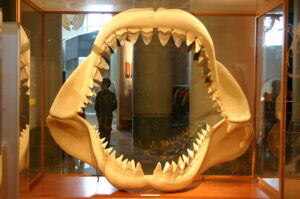
Ryan Somma (CC BY-SA 2.0) from Wikimedia
Sharks and sharp teeth go hand in hand. But not all sharks have sharp teeth or conventionally use them. Teeth are common in basking sharks and megalodons. But their usage is different.
Basking sharks do not need to tear their food, as they are filter feeders. As a consequence, even when they have an average of 1,500 teeth, they only use them to chew small fish, etc. they don’t really bite to chop off their prey’s flesh. However, the meg was entirely different, as they had 7 inches long teeth with a bite force of 40000psi.
Since basking sharks possess 5–6 mm long teeth, at a first glance, they look toothless. And this could be cited as one of the biggest differences between these sharks and the meg. As a result, in a potential fight between a basking shark and a meg, the latter would surely have the victory.
The megalodon wins with the longest teeth and the great bite force over the basking shark.
Will a Megalodon Eat a Basking Shark in a Fight?
Since the megalodon was the largest shark to ever live on earth, it is fascinating to imagine if they would have indulged in fights with the largest modern-day sharks.
Given their aggressive character, and massive size, the megalodon might not have minded putting up a battle with the basking shark. Experts discovered that, in the past, humpback whales were megalodon’s combatants. As a result, it is reasonable to presume that basking sharks would have been in a similar scenario.
Apart from the size, several other factors would have made basking sharks vulnerable in front of megalodons, like
- Their lack of teeth
- Non- aggressive nature
- Lack of defense system
- Fewer senses than megalodons
- Insufficient fighting prowess
- Low swim speed, etc
Basking Shark vs. Megalodon: Swim Speed
Swimming is not just a way to move in the water for sharks, it is also the only way to intake oxygen for some of them. However, the swimming speed tends to vary for different sharks.
If compared between a basking shark and a megalodon, the latter had a better swim speed. A megalodon could swim at a speed of 11 mph. On the contrary, a basking shark can move forward, in the water, at 2.5- 4 mph only.
Here, it should be noted that, as a thumb rule, sharks usually swim at a speed of almost 5 mph. It is only when they are attacking prey, they increase their swimming speed and take short bursts.
In terms of swim speed, of course, the once mammoth shark- the meg- is the winner.
Basking Shark vs. Megalodon: Defense Systems
When it comes to the defense system, shark uses a combination of things, like their size, sharp teeth, vicious bite, camouflaging, acute sense, etc. Let’s delve into the defense system of a basking shark vs. a meg.
Megalodons were blessed with acute senses of smell, vision, hearing, and Ampullae of Lorenzini. Also, they were intellectual fishes that used massive jaw strength and bite force to kill and devour prey. On the other hand, a basking shark has only its massive size to deter prey. Also, despite having teeth, they are non-usable when it comes to tearing off the victim.
Basking sharks are giants but at the same time gentle and passive. These fishes are not active predators, and hence, do not possess active defense systems like the megs.
The megalodon is the clear winner in possessing a stronger and better defense system.
Verdict
This brings us to the end of this article. In this article, we used a comparison model to shed light on various features of basking sharks and megalodons. Finally, we can say that in a confrontation between a basking shark and a meg, the latter would always be the victor. Although basking sharks are the world’s second-largest fish, they are dwarfed and weak in comparison to the giant megalodons.

